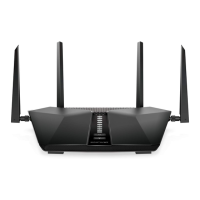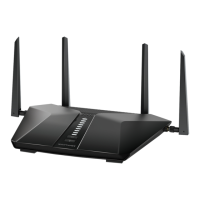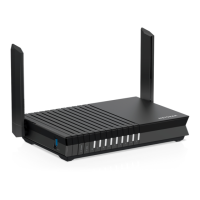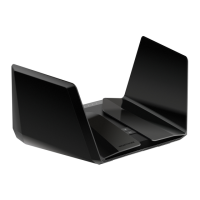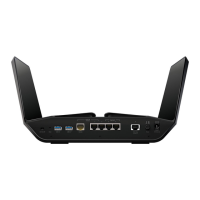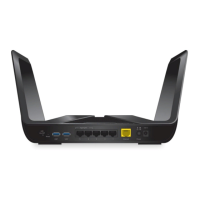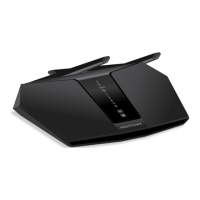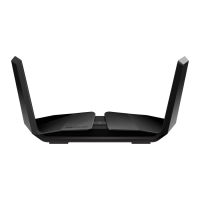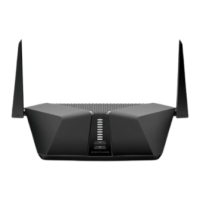
Do you have a question about the NETGEAR RAX40 and is the answer not in the manual?
| Brand | NETGEAR |
|---|---|
| Model | RAX40 |
| Category | Wireless Router |
| Language | English |
Unboxing the router, power adapter, and Ethernet cable for initial setup.
Locating status LEDs and buttons on the router's top panel for hardware identification.
Identifying connectors and buttons on the router's rear panel.
Locating login info, WiFi name (SSID), password, serial, and MAC address.
Guidelines for optimal router placement to maximize WiFi range and performance.
Connecting the router to the modem and power outlet for initial setup.
Establishing a wired or WiFi connection to the router's network.
Understanding different login types: ISP, WiFi, NETGEAR account, and router admin.
Using a web browser to access the router's interface for setup and management.
Using the Nighthawk app for router installation, updates, and personalization.
Modifying the language displayed in the router's web interface.
Utilizing the wizard to automatically detect and configure Internet connection settings.
Manually configuring WAN settings like IP address, DNS, and MAC address.
Setting up IPv6 connectivity using Auto Detect, Auto Config, 6to4 Tunnel, Pass Through, Fixed, DHCP, or 6rd.
Adjusting the Maximum Transmission Unit (MTU) for optimal Internet communication.
Configuring rules to allow or block device access to the Internet based on MAC addresses.
Blocking access to specific websites by entering keywords or domain names.
Managing lists of allowed or blocked devices for network access.
Setting a schedule for when Internet sites and services are blocked.
Configuring email alerts for security events and activity logs.
Configuring Wide Area Network (WAN) settings like DMZ, MTU, and NAT filtering.
Designating a DMZ server to bypass firewall for specific applications, posing a security risk.
Modifying Local Area Network (LAN) IP address, subnet mask, and RIP settings.
Assigning static IP addresses to devices by reserving them via MAC address.
Configuring WiFi network name (SSID), security type, and channel for 2.4 GHz and 5 GHz bands.
Modifying the WiFi password (network key) and selecting security protocols like WPA2/WPA3.
Creating a separate WiFi network for guests with customizable security and access options.
Turning the router's WiFi radios on or off via the web interface.
Configuring the router to function as a Wireless Access Point (AP) on an existing network.
Adding static routes for specific network traffic paths, typically for complex network setups.
Controlling the router's ability to improve WiFi signals by using client device information.
Managing how WiFi airtime is distributed among connected devices to prevent slow clients impacting performance.
Enabling Dynamic Quality of Service (QoS) to prioritize Internet traffic for better application performance.
Enabling Universal Plug and Play (UPnP) for easier device discovery and automatic network resource configuration.
Prioritizing WiFi voice and video traffic using WMM QoS for smoother multimedia experiences.
Controlling the router's WiFi 6 (AX) capabilities for improved network capacity and speed.
Managing Smart Connect to automatically assign devices to the optimal WiFi band (2.4 GHz or 5 GHz).
Checking for and installing the latest firmware updates to improve performance and security.
Modifying the router's administrative login password for enhanced security.
Setting up password recovery questions and answers to regain access if the admin password is forgotten.
Checking the router's status, Internet connection, and WiFi settings using color-coded icons.
Verifying the router's current Internet connection status, IP address, and lease information.
Backing up, restoring, or erasing the router's configuration settings to preserve or reset them.
Configuring the router to allow remote management access over the Internet via IP address and port.
Adjusting the router's time zone for accurate logging and scheduling.
Resetting the router to its original factory default settings using the Reset button or Erase function.
Understanding supported USB file system types and device compatibility for ReadySHARE.
Physically connecting a USB storage device (flash drive, HDD) to the router's USB port.
Accessing files on a connected USB storage device from a Windows computer via the network.
Assigning a drive letter to the USB storage device for easier access in Windows File Explorer.
Accessing files on a connected USB storage device from a Mac computer using Finder.
Using NETGEAR's ReadySHARE Vault software for automated backups of Windows computers to USB storage.
Configuring Time Machine on Mac computers to back up data to a USB storage device connected to the router.
Allowing faster download/upload of large files via File Transfer Protocol (FTP) within the network.
Browsing and viewing folders and files available on the USB storage device.
Creating new network folders on the USB storage device for organized file sharing.
Modifying settings for existing network folders on the USB storage device.
Safely taking the USB storage device offline before physically disconnecting it to prevent data loss.
Configuring the router to act as a DLNA/UPnP AV media server for viewing media on compatible devices.
Enabling TiVo support to access media files on USB storage via a TiVo device.
Configuring Dynamic DNS to access the home network using a domain name instead of a changing IP address.
Enabling FTP access to the USB storage device via the Internet using the configured Dynamic DNS service.
Setting up a personal FTP server using Dynamic DNS for remote access to network files.
Accessing USB storage devices remotely through the Internet using Dynamic DNS or the router's IP address.
Using NETGEAR ReadyCLOUD service and app to remotely access files on USB storage devices connected to the router.
Configuring the router to enable VPN service, specifying connection type and port for secure remote access.
Setting up the router's VPN service parameters, including service type (TCP/UDP) and port number.
Installing OpenVPN client software on Windows, Mac, iOS, or Android devices for VPN connections.
Establishing a VPN tunnel from a Windows computer to the router for secure access to the home network.
Accessing USB storage devices and media files on the router's network using an established VPN connection.
Routing Internet traffic through the VPN connection to access your home network's Internet service remotely.
Configuring rules to forward incoming Internet traffic to specific servers or applications on the local network.
Setting up dynamic port forwarding rules that open ports based on outbound traffic for specific applications.
General troubleshooting steps including restarting the network and checking cable connections.
Interpreting router LED status indicators to diagnose and troubleshoot connection or hardware issues.
Resolving issues preventing login to the router's web interface, checking credentials and connections.
Diagnosing and resolving problems preventing Internet access, checking WAN IP and ISP settings.
Addressing issues with loading web pages, including traffic meter limits and DNS server configurations.
Resolving problems where router configuration changes are not being saved, emphasizing the Apply button.
Diagnosing and fixing issues with connecting to the router's WiFi network, checking settings and signal strength.
Using the ping utility to test network paths and diagnose connectivity issues between devices.
Details of the router's default factory settings for various features, accessible via reset.
Overview of the router's technical specifications, including hardware, protocols, and compliance standards.

